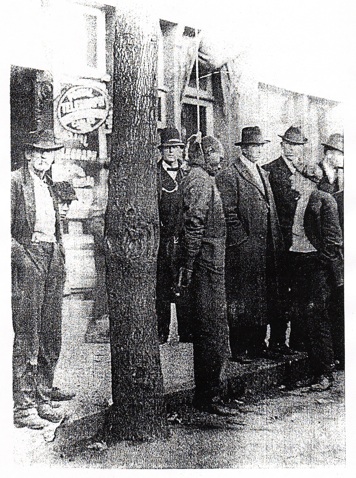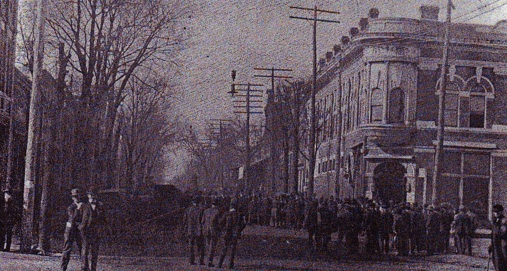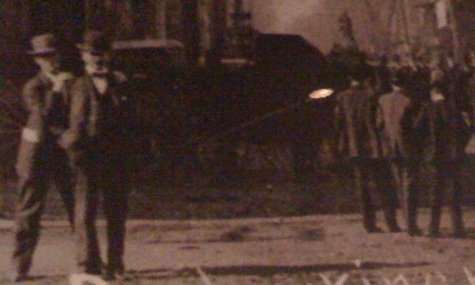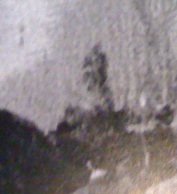
According to a 26 February 1916 article in The Sun Herald of Lime Springs, Iowa: "... Cartersville, Ga. ... Jesse McCorkle, a negro was taken from jail here by half a hundred men and boys, hanged to a tree in front of the city hall and his body riddled with bullets. McCorkle was arrested for breaking into the home of A. T. Heath and attacking Mrs. Heath, whose husband was away. The woman shot the negro in the wrist with a revolver, but she was overpowered. When caught McCorkle's wounded wrist was still bleeding and he had the revolver ...". Here is a photograph of the 1916 lynching of Jesse McCorkle:

That the lynching took place during the night or early morning,, is clear from what Ed Bostick said in his article "Lynchings in Bartow County" (Etowah Valley Historical Society Volume 69, October 2008): "... The wife of William Weinman ... was said to be reluctant to move to the South from New York because of the violent social atmosphere, especially that of the lynch mentality. Mr. Weinman, after considerable cajoling, was able to convince her that lynchings were rare and that she would find Cartersville to be a congenial place. During a visit, the couple registered at a hotel in the public square. Mrs. Weinman retired for the night and awoke the next morning to the sight of the dangling corpse of Jesse McCorkle. ...".
[ I wonder whether Mrs. Weinman's reluctance may have been due to premonition of her son Andrew being killed in a fight in Cartersville.]
During the day, Jesse McCorkle's body was cut down from the tree and carried around for display and abuse. This picture

is described on page 10 of a book of images of Bartow County, Georgia, by Michele Rodgers (The Bartow History Center) as a ".... c. 1908 view of Cartersville's Main Street, looking west from the Western and Atlantic Railroad tracks ...".
However, if you look closely at the picture

it seems to me the same 5 men (one in a grayish hat, one in a black hat, and three standing together) were around Jesse McCorkle's body when it was cut down (first picture on this web page) and in the foreground of the crowd picture. The three men were wearing overcoats in the first picture, but not in the crowd picture, probably because the crowd picture was taken later in that February day (the shadows indicate around noon) when it was warmer, so I think that the picture not "... c. 1908 ..." but is of the 1916 lynching.
The crowd seems to be watching Jesse McCorkle's body being paraded around for display and abuse.

In his EVHS article, Ed Bostick said "... "Public sentiment, both among the white and negro races, appears to sanction the summary execution and little was heard of the matter twelve hours after it was over." ...".
Arthur Raper said in his book "The Tragedy of Lynching" (Dover 2003 republication):
"... John Willie Clark, born at Vienna, Dooly County, Georgia, October 23, 1907, was one of a family of ten. His father died in 1918. Five years later Clark's mother moved to Chattanooga, where she has lived since, making a living by taking in washing. ... John Willie attended school but very little. He left home when he was twelve years old, shortly after his father's death, and since then had never lived with his mother more than a few weeks at a ttime. After leaving home he worked around garages. ... Prior to ... November, 1929 ... he had sent her a little money at irregular intervals; since then she had received no assistance from him. ... Clark had been in the courts on several occasions, having been arrested a number of times by Cartersville officers on charges of theft and having liquor. ...".
Ed Bostick said in his article "Lynchings in Bartow County" (Etowah Valley Historical Society Volume 69, October 2008):
"... John William (Willie) Clark was a 22-year-old black male escapee from the Murray County chain gang where he had been serving a sentence for auto theft. At about 1:00 AM during the night of 4-5 September 1930, Clark and his brother were drinking whiskey while parked in a car at the corner of Douglas and Carter streets in Cartersville ... in front of the home of Joe Ben Jenkins, 65 years old and Cartersville's chief of police for the previous twelve years.
[ The outside of the Joe Ben Jenkins house has not changed much since 1930.Carter Street (to the right in the above picture) is along the side of the house and Douglas Street (to the left in the above picture ) is along the front of the house. The front door of the house
is in a porch facing Douglas Street ]
Chief Jenkins, armed with a pistol and dressed in his nightclothes, approached the vehicle ... They became argumentative and Chief Jenkins informed them that they were under arrest ... At the same time, Mr. Oscar (Shorty) Green, a local cotton mill employee was driving by on his return from working a late shift. The chief hailed him down ... handed Green his pistol, and requested him to hold the suspects until he could return to his home to dress. As Chief Jenkins turned to enter his house, Willie Clark attempted to start his car. Retrieving his pistol from Green, the chief stepped closer to the vehicle and ordered Clark from the car. Clark grabbed the pistol and a struggle began. Clark was jerked out of the car and was struck on the head by a brick thrown by Oscar Green. ... Clark ... fired two shots. The first shot struck Chief Jenkins under the right eye and the bullet penetrated the brain, killing him instantly. The second shot was aimed at Oscar Green and grazed his ear. Green also sustained some severe bites during the struggle. Clark's brother fled the scene and Willie Clark drove away in the stolen Model A Ford with license plates from Cuthbert, Georgia. Chief Jenkins' son-in-law, Hugh Pettit, rushed out of the house in time to see his father-in-law shot and the car being driven away... Just before dawn, on South Bartow Street, Hugh Pettit discovered the stolen Ford ... Bartow County Commissioner A. V. Neal and Cartersville Mayor Jack Hill offered a reward of $1000 for the capture of Willie Clark ... Chief Jenkins' pistol was recovered in Chattanooga where it had been sold. ... Willie Clark was captured in Murray County on 9 September. He was wounded in the leg during the chase. ... During the ride to Cartersville, Clark admitted that he had fired the shot that killed Chief Jenkins but claimed that it was an accident. ...".
Arthur Raper also said in his book "The Tragedy of Lynching" (the names in brackets [ ] are from a Bartow Herald newspaper article dated 2 October 1930):
"... Clark ... was placed in the Cartersville jail ... people began to congregate in great numbers ... the crowd was becoming more threatening ... a Negro educator from central Georgia happened to be motoring through Cartersville ... He .. sensed ... that a lynching was very probable. He immediately got in touch with some of the leading Negroes in Cartersville whom he knew personally. They were unwilling to take a definite stand in the matter, feeling that any aggressivelness on their part would be resented by the white people ... the Negro educator got into telephone connection with an outstanding Atlanta lawyer, who, in turn, called Governor Hardman ... National ... Guardsmen were immediately ordered to Cartersville ... The accused Negro was moved to Atlanta for safe keeping. ... When the trial came up on the last day of September, the presiding judge [Claude Pittman] appointed local counsel [William Ingram and Robert Whitaker] for Clark. Much to the suprise of the judge and to the obvious displeasure of hte people who jammed the courtroom, three lawyers from Atlanta [Harold Sheats, Marion Williamson, and George C. Dean] appeared in court ...[and moved]... for a change of venue ... The lawyers insisted that the case go to Floyd, or to Fulton, or to some other county south of Fulton. ... The judge ...called before the court a number of leading citizens [George Gaddis, A. V. Neal, T. W. Tinsley, R. V. Jones, Charlie Mayes, Bill Knight, W. C. Walton, O. T. Peebles, and M. L. Fleetwood] to ascertain whether they thought the Negro could secure an impartial trial. Without exception they stated that he could. ... The judge ruled that a change of venue was not necessary. The ... lawyers then entered an exception to the judge's action, which automatically stayed the trial until a ruling could be had from the State Supreme Court ... the defense lawyers reuested the judge to provide an armed escort for Clark back to Atlanta for safekeeping. The judge refused to send him back ... That night Clark was lynched ... [ Here is a photo of his body taken the next day
Louis Mazzari in his biography of Arthur Raper "Southern Modernist" (LSU Press 2006) said: "... Raper drove down to Cartersville the day after ... the lynching ... Two photo studios were ... selling postcards of the lynching. At Morris Studio, Mr. Morris had been pleased he could get such a good shot. He was charging a quarter apiece. Over at Art-Craft Shop, though, they sold them for just a dime.... the photgrapher explained to Raper ..."You know ... the pictures of that Negro hanging there will do more to reduce crime than anything I know of, and I am glad to distribute the pictures at cost. ... "This man reported with delight that pictures of the lynching were being sold at Calhoun, Rome, Chattanooga, and various other places, and that he believed it would do a great deal of good." ... Raper was only in the store a few minutes, but several people came in for postcards. ...". ]
the sheriff [George Gaddis], sleeping in a room adjoining the one occupied by the deputies in charge, reported that he did not know the mob had come to the jail until they were leaving with the prisoner. The judge [Claude Pittman] expressed satisfaction that there had been no mutilations,
[If there were in fact no mutilations, I wonder why the fly of John Willie Clark's pants is open.According to a web page at www.capitalpunishmentuk.org/hanging2.html "... Male prisoners sometimes have penile erections (priapism) after hanging ... Men may also reach orgasm on the rope ...".
Perhaps (I don't know for sure) John Willie Clark had an erection when hanged, and his pants fly was opened to cut off his penis, and perhaps the rest of his genitals. ]
and suggested that this indicated the "orderly" way in which the lynching was effected and the "high class" of people who did it. ...
The Bartow Herald, Cartersville weekly paper ...editoral policy ... subsequent [to the lynching]... was in conformity with peace officers, court officials, and the general citizenry of the town and county in either condoning or justifying the lynching.
On the day following the lynching one of the county commissioners gave a statement to the press ... A part of his statement was:
"... The people of Cartersville and Bartow County were a unit in agreement that Clark should have a fair and impartial trial, feeling sure that the sentence would have been dath in the electric chair.
"Howeve, the action taken by the Atlanta lawyers causing postponement ... so incensed our people that ... the action ... is not only condoned, but has met with practically unanimous approval." ...
the public looked in vain to Cartersville for a repudiation of the statement. When none was forthcoming, an effort was made by an Atlantan to get at least a few leading citizens to say publicly that they did not justify the lynching. There were some who disapproved ... but none was willing to say so publicly. ..
... The various local justifications for the lynching constitute a sorry picture indeed. Doubtless the most prevalent justification was that any Negro who killed a white man ought to be lynched. The next most common justification was that the Atlanta lawyers, "outsiders", by postponing the trial, "broke" the "contract" with the original mob members that Clark would be tried and executed without delay ... .
Others justified the lyhnching on the ground that Clark's money, secured by burglaries and auto thefts, and used to employ able defense lawyers, should not be permitted to save him from an immediate death sentence. ... another justification was ... that Clark was a paid agent of Al Capone's rum ring, and that he had been sent to Cartersville to get Chief Joe Ben Jenkins out of the way so Capone's liquor trucks could go unmolested from the Florida ports to Chicago, for along the whole way only the Cartersville Chief ... had refused to be "bought off" by the rum runners. ...
The defense lawyers staed positively that the small fee promised them was to be paid by the accused Negro and his family, and that they had no reason whatever to believe that any auto theft gang or rum ring was interested in the case ... The Atlanta lawyers became identified with the case when one of them, a member of the National Guard unit at Cartersville ten days before the lynching, was asked by Clark to defend him. He and his associates became intensely interested in the case when upon investigating they began to doubt that Clark was guilty of first degree murder and to fear that he would be "railroaded" to his death. ...".
There is an answer to the two "interesting questions" stated above, but I have never seen it in any written discussion of the lynching of John Willie Clark. Back in the 1960s, when I was studying law I was working as an apprentice in the law office of William A. Ingram, one of the lawyers for John Willie Clark. It was a small law office, just Judge Ingram (the title from his prior service as a judge) and his secretaries Cola Mae Vaughan and Annette Hufstetler, and me as apprentice, and there was a lot of informal conversation, including Judge Ingram's personal description of his involvement as attorney for John Willie Clark.
For instance, Judge Ingram said that when he came to town the morning after the lynching, people came up to him, saying: "Judge Ingram, your appeal is a-hanging from a light pole."
As to Why would the local powers-that-be (Sheriff, Judge, Newspaper, County Commissioner) expressly approve a lynching ?
Judge Ingram said that they were determined to cover up the fact that Joe Ben Jenkins was having sex with the wife of John Willie Clark, which fact would have been made public in a full trial.
That also answers the other question Why would a Chain Gang Escapee park in front of the home of a Chief of Police ?
Most likely, when John Willie Clark escaped he went home, but his wife was not there. He knew that when he had "been arrested a number of times by Cartersville officers on charges of theft and having liquor", some of those arrests had been to get him out of the way so that Joe Ben Jenkins could take the wife of John Willie Clark to the house of Joe Ben Jenkins for a night of sex (probably in a nicer feather bed than the bed at John Willie Clark''s house). So, John Willie Clark figured that his wife was in Joe Ben Jenkins' house, and he drove there (with his brother) but had trouble getting up enough nerve to go in and try to get her out, so he and his brother were parked there drinking trying to get up their nerve when Joe Ben Jenkins came out of his house "armed with his pistol and dressed in his nightclothes", and the confrontation took place.
and why the local powers-that-be would fear that a trial would make public the interracial sexual activity between the Cartersville Chief of Police and the wife of John Willie Clark.
The next questions are:
Although I am old, I am not old enough to have known the Wife of John Willie Clark, except by what I have heard from my elders, which is: she, like John Willie Clark, was around her 20s in age; she was light-skinned; she was the most attractive, sexy, woman in Bartow County; and she had a number of white lovers.
Due to their race, she and John Willie Clark were vulnerable to intimidation by white people with power (as a Police Chief who could arrest people), money, and influence, so she in fact had little choice but to submit to sex with powerful, rich, influential white people, and she (and he) probably just endured such abuse.
However, when John Willie Clark was lynched to keep her sexual activity secret from the public, she knew that she would be regarded as a risk to talk, she rightly feared for her own life, so she left for parts unknown.
Unfortunately, that is all I know about her, but I wish that someday I might find out what the rest of her life was like.
Joseph Benjamin Jenkins's first wife, maiden name Elllis, died, then he married her sister Rena Ellis, who died around 1920 or so.
Children of first marriage included:
Children of second marriage were:
At the time of the John Willie Clark lynching, Joseph Benjamin Jenkins was twice a widower, so he probably felt that it was OK to have sex because he was not cheating on a wife. Unfortunately, he did not regard it to be immoral to have that sex with the wife of another man.
In fairness to Joseph Benjamin Jenkins, he (being dead) had no part in the lynching to cover up his interracial sex. Had he survived the gunshot and only been wounded, he might have come clean and admitted his activities, thus to some extent exonerating John Willie Clark. However, he did die, and what he might or might not have done had he survived will never be known to us here on Earth.
I should mention that I have connections with Joseph Benjamin Jenkins through his daughter Marguerite Jenkins Pierce, who was only 12 years old he was killed. After then, she was raised by Bertha and Hugh B. Pettit, Sr., the couple known to me as Nanny and Unk.
When I was born in March 1941, in the same hospital, at about the same time, Marguerite gave birth to her first son John W. Pierce, Jr. My birth was difficult. Dr. Sam Howell had to reach up with his hands inside my mother to untangle me from the cord, resulting in a severe infection at a time when there were no antibiotics (other than sulfa drugs, which were difficult for my mother to take). My mother was unable to nurse me, but Marguerite was good enough to nurse both her son John and me. Since John and I nursed together like twins, we have always been very close, and are also close to his brothers, especially his younger brother Joseph G. Pierce. Sadly, Marguerite died on 18 April 2006, and she and her husband John W. Pierce are buried in the same plot at Oak Hill cemetery in Cartersville as Joseph Benjamin Jenkins, not far from the plot where my parents and paternal grandparents are buried.